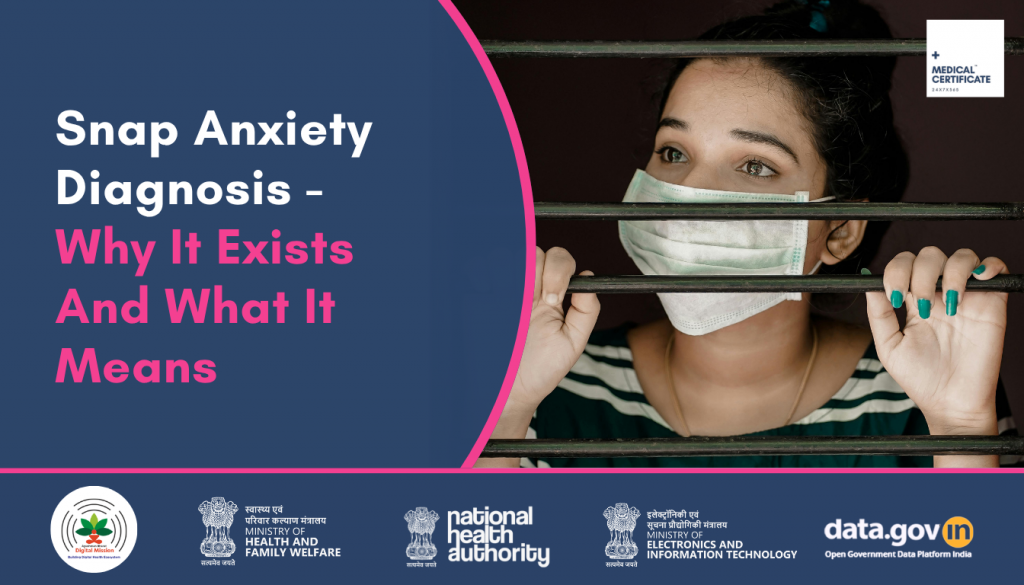
Snap Anxiety Diagnosis: Why Everyone Thinks They Have Anxiety (And What That Means)
1. What Is Snap Anxiety Diagnosis?
Ever caught yourself watching a 15-second reel that lists “7 Signs of High-Functioning Anxiety” and went like, “Wait… is this me?”
You are not alone.
We exist in an era where the content on mental health is rampant, be it in the form of Instagram posts and TikTok snippets, Reddit threads or even WhatsApp forwards. And although it is fantastic that mental health has ceased to be a taboo topic to discuss, there is one particular trend that has risen, and that is people self-diagnosing anxiety (and other disorders) on the basis of brief digitalised content. It is what we term Snap Anxiety Diagnosis, an immediate, superficial self-diagnosis of anxiety without the services of a professional.
It’s not inherently bad, but it’s not always helpful either.
2. The Rise of DIY Mental Health Labels
Google “Why do I feel anxious all the time?” and you’ll get over 100 million results.
We’re now part of a generation that:
- Has high access to mental health information
- Has low access to affordable therapy
- And spends more time online than talking to real doctors
With hashtags like #mentalhealthawareness, #anxietycheck, and #relatable, everyone is seeing mental health content and seeing themselves in it. This is particularly true for:
- Students who are under academic and social pressure
- Working professionals dealing with burnout
- New parents juggling responsibilities and sleepless nights
The National Mental Health Survey in India indicates that 1 in 10 people are likely to suffer to some degree of anxiety disorder, and in the world it is estimated that, the WHO estimates are 301 million.
So yes, anxiety is real. However, not all people who are exhausted, overthinking, and overscrolling suffer from an anxiety disorder.
3. Why Do So Many People Diagnose Their Own Anxiety?
A few reasons:
- Instant Content, Instant Connection: Mental health reels and carousels speak directly to our feelings, quick dopamine hits with “aha, that’s me” moments.
- Accessibility Issues: Both in India and overseas, therapy is stigmatised or costly, particularly in conservative or rural communities.
- Emotional Validation: People want to feel understood and seen. Giving their uneasiness a name by calling it “anxiety”
- Cultural Shift: We’re more mental health aware, but not necessarily mentally health literate.
In short: we want clarity. And we want it now.
4. Symptoms of Anxiety vs Everyday Stress: The Blurred Line
| Symptom | Normal Stress | Possible Anxiety Disorder |
| Worry | Situation-specific (exams, deadlines) | Persistent, about many things |
| Sleep | Occasionally disturbed | Regular insomnia or disturbed sleep |
| Focus | Distracted during high pressure | Consistently unable to concentrate |
| Body | Tension, sweaty palms during stress | Physical symptoms without clear triggers |
| Mood | Irritable occasionally | Irritability as a daily pattern |
What we forget is, feeling anxious occasionally is part of being human. Anxiety disorder is when it becomes chronic, unmanageable, and affects daily functioning.
5. Social Media, Reels, and the Age of Relatable Psychology
Let’s be honest: there’s a reel for everything.
“5 signs you’re an introvert with anxiety.”
“POV: You cancel plans because your social battery died.”
“Are you anxious, or just overbooked?”
These can be funny and helpful. They help normalise conversations and reduce stigma.
But here’s the problem: relatable doesn’t mean diagnosable.
You can feel anxious and not have Generalised Anxiety Disorder (GAD). You can overthink and not have OCD. You can hate crowds and still not need clinical help, unless it’s disabling your life.
Social media’s biggest strength, making people feel seen, is also its biggest weakness. Complexity is reduced to 60-second summaries.
6. Does Self-Diagnosis Pose a Risk? The Sword with Two Edges
Not always. But here’s what can go wrong:
- Over-pathologising normal behaviour: You’re human, not broken.
- Missing deeper issues: Maybe your anxiety is actually burnout, depression, or even a thyroid issue.
- Self-medicating without guidance: Some people jump to supplements or even prescription meds.
- Avoiding real help: “I already know what I have, I just need to deal with it” Does that sound familiar?
Yet, snap diagnosis isn’t all bad.
✅ It reflects rising awareness.
✅ It can prompt someone to seek therapy.
✅ It can create a vocabulary for emotional experience.
The key is knowing when it’s time to move from content to consultation.
7. So… Do You Actually Have Anxiety?
Here’s a basic distinction checklist. But remember, this is not a diagnostic tool.
Likely Everyday Anxiety:
- Worrying about results, work, or family occasionally
- Overthinking social situations, then moving on
- Having physical symptoms during clear stress
May Need Professional Input:
- Worry that never stops, even in “happy” times
- Avoiding events, people, or tasks due to fear
- Panic attacks without reason
- Physical signs and symptoms that have no known cause
- Chronic restlessness, irritability, or insomnia
Not only anxiety but an anxiety disorder might be the case when they are getting in the way of your identity, relationships, or are affecting your day-to-day functioning.
8. The Right Way to Seek Help
Instead of staying stuck in “I think I have anxiety,” take steps that move you from confusion to clarity:
- Get Screened: To begin with, you can complete a brief mental-health screening. Even a simple self-test of a reliable and science-based source can make you aware of whether you require more thorough assistance.
- Speak to a Professional: It could be a psychologist, a psychiatrist or a licensed mental health expert, but obtaining a professional opinion can be the difference. Anxiety can be controlled, however, only when it is treated properly.
- Opt for Online Consultations: Online consultations are a versatile option in case it seems like a barrier to schedule face-to-face therapy. A session at home is confidential, convenient and frequently more accessible, which eliminates the first-time jitters.
- Support Through Lifestyle: Simple routines like journaling, screen breaks, improved sleep, light movement, or even simply establishing boundaries can have a profound impact. These are supplements, not a substitute for professional care, though, when needed.
It is also permitted to postpone anxiety in case it becomes disruptive to your day-to-day routine. Medicalcertificate.in is a private online consultation and at times rest or mental health certificates that will guide you to take time off and not hide or fight. A legit break is part of real healing because sometimes.
9. Final Thoughts: Awareness Is Power, Not a Label
Snap anxiety diagnosis isn’t a trend to cancel; it is a signal that people want mental health literacy. And that’s a good thing.
But it’s important to ask:
- Are we over-labelling human experiences?
- Are we replacing healing with hashtags?
- Are we consuming therapy as content, but avoiding therapy as commitment?
Understanding your emotions is powerful. But so is reaching out to someone trained to help.
Let’s normalise therapy, not just reels about it.
Do not rely on social media alone in case you are not sure whether it is clinical anxiety or if you just had a bad week. Your first step is awareness, and the support is the bridge.
